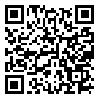Volume 20, Issue 6 (Jan-Feb 2013)
JSSU 2013, 20(6): 732-742 |
Back to browse issues page
Download citation:
BibTeX | RIS | EndNote | Medlars | ProCite | Reference Manager | RefWorks
Send citation to:



BibTeX | RIS | EndNote | Medlars | ProCite | Reference Manager | RefWorks
Send citation to:
Rostami R, Biravand A, Estabraghnia H, Aghasi M, nourooz-zadeh J. Evaluation of Goiter Prevalence and Iodine to Creatinine Ratio among School-aged Girls in Urmia County . JSSU 2013; 20 (6) :732-742
URL: http://jssu.ssu.ac.ir/article-1-2284-en.html
URL: http://jssu.ssu.ac.ir/article-1-2284-en.html
Abstract: (10405 Views)
Introduction: Clinical evaluation of iodine deficiency disorders (IDDs) is often accomplished by assessment of urinary iodine excretion (UIE) in random samples however, the utilization of 24 hour urine samples is a more reliable biomarker of nutritional iodine status. This study was designed to evaluate total goiter prevalence (TGP) and iodine/creatinine ratio among school-aged children in Urmia County.
Methods: Schoolchildren (n=500) were recruited by cluster sampling from different educational areas in Urmia County. Goiter prevalence was assessed by thyroid palpation, UIE was determined by Sandell-Koltoff reaction, and Urinary creatinine was measured by the Jaffe-method.
Results: In general, TGP was 12.2%. Among these, there were 48 individuals (9.6%) with grade I goiter and 13 subjects (2.6%) with grade II goiter. Mean urinary creatinine, median UIE and median I/Cr ratio were respectively 1.36±0.76 mg/dL, 14.3µg/dL, and 11.5µg/mg. Prevalence of iodine deficiency according to UIE criteria was 22.8% and that of I/Cr ratio was 41.2%. There was a correlation between age and UIE (P=001 r=0.163). UIE and urinary creatinine were correlated as well (P<0.003 r= 0.133). A correlation was also detected between I/Cr ratios and UIE (P=0.003 r=0.133) whilst a negative association was seen between age and I/Cr ratios (P=0.001 and r=–0.263).
Conclusion: This investigation reconfirms that there is slight-to-mild iodine deficiency in Urmia County. The utilization of I/Cr ratio in conjugation with UIE and palpation may provide a better assessment in investigating nutritional iodine status.
Keywords: Goiter; Iodine/creatinine ratio; Iodine deficiency; Schoolchildren; Urinary iodine excretion
| Rights and permissions | |
 |
This work is licensed under a Creative Commons Attribution-NonCommercial 4.0 International License. |





